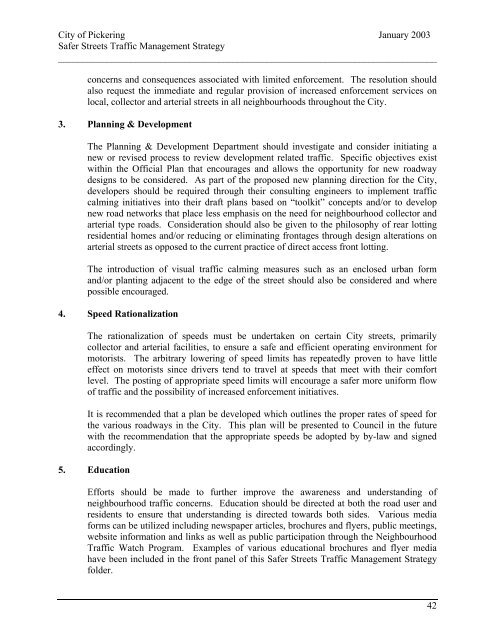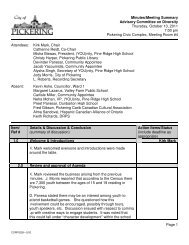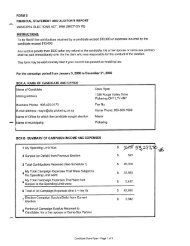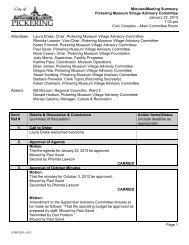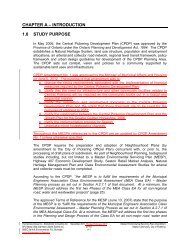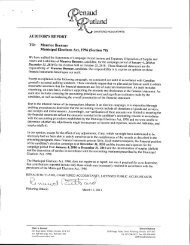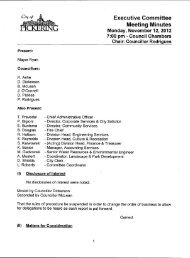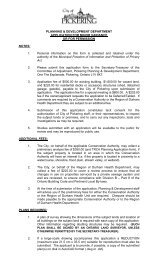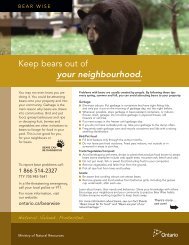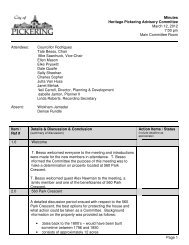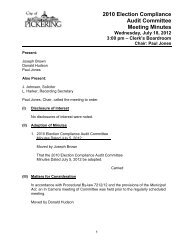foreword - City of Pickering
foreword - City of Pickering
foreword - City of Pickering
You also want an ePaper? Increase the reach of your titles
YUMPU automatically turns print PDFs into web optimized ePapers that Google loves.
<strong>City</strong> <strong>of</strong> <strong>Pickering</strong> January 2003<br />
Safer Streets Traffic Management Strategy<br />
______________________________________________________________________________<br />
concerns and consequences associated with limited enforcement. The resolution should<br />
also request the immediate and regular provision <strong>of</strong> increased enforcement services on<br />
local, collector and arterial streets in all neighbourhoods throughout the <strong>City</strong>.<br />
3. Planning & Development<br />
The Planning & Development Department should investigate and consider initiating a<br />
new or revised process to review development related traffic. Specific objectives exist<br />
within the Official Plan that encourages and allows the opportunity for new roadway<br />
designs to be considered. As part <strong>of</strong> the proposed new planning direction for the <strong>City</strong>,<br />
developers should be required through their consulting engineers to implement traffic<br />
calming initiatives into their draft plans based on “toolkit” concepts and/or to develop<br />
new road networks that place less emphasis on the need for neighbourhood collector and<br />
arterial type roads. Consideration should also be given to the philosophy <strong>of</strong> rear lotting<br />
residential homes and/or reducing or eliminating frontages through design alterations on<br />
arterial streets as opposed to the current practice <strong>of</strong> direct access front lotting.<br />
The introduction <strong>of</strong> visual traffic calming measures such as an enclosed urban form<br />
and/or planting adjacent to the edge <strong>of</strong> the street should also be considered and where<br />
possible encouraged.<br />
4. Speed Rationalization<br />
The rationalization <strong>of</strong> speeds must be undertaken on certain <strong>City</strong> streets, primarily<br />
collector and arterial facilities, to ensure a safe and efficient operating environment for<br />
motorists. The arbitrary lowering <strong>of</strong> speed limits has repeatedly proven to have little<br />
effect on motorists since drivers tend to travel at speeds that meet with their comfort<br />
level. The posting <strong>of</strong> appropriate speed limits will encourage a safer more uniform flow<br />
<strong>of</strong> traffic and the possibility <strong>of</strong> increased enforcement initiatives.<br />
It is recommended that a plan be developed which outlines the proper rates <strong>of</strong> speed for<br />
the various roadways in the <strong>City</strong>. This plan will be presented to Council in the future<br />
with the recommendation that the appropriate speeds be adopted by by-law and signed<br />
accordingly.<br />
5. Education<br />
Efforts should be made to further improve the awareness and understanding <strong>of</strong><br />
neighbourhood traffic concerns. Education should be directed at both the road user and<br />
residents to ensure that understanding is directed towards both sides. Various media<br />
forms can be utilized including newspaper articles, brochures and flyers, public meetings,<br />
website information and links as well as public participation through the Neighbourhood<br />
Traffic Watch Program. Examples <strong>of</strong> various educational brochures and flyer media<br />
have been included in the front panel <strong>of</strong> this Safer Streets Traffic Management Strategy<br />
folder.<br />
42


